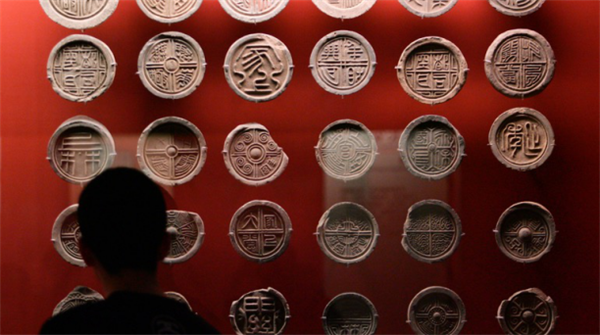
The Shaanxi History Museum in Xi’an, regarded as “the pearl of ancient dynasties and house of Chinese treasures”, gives a miniature overview of the thousands of years of Chinese history and the splendid ancient cultures of olden times.
Situated on Xiaozhai East Road on the northwest side of Big Wild Goose Pagoda, the Shaanxi History Museum is the first modern national museum. It was built in 1983 and opened to the public in 1991. It covers 65,000 square meters (16 acres), of which 11,000 square meters (207 acres) belong to the exhibition halls and 8,000 square meters (about 2 acres) are used as warehouses for storing relics. Now 370,000 exhibits in the museum vividly show the history of over a million years from prehistoric times (1,150,000 years ago - 21st Century BC) to about 1840 AD.
The grand buildings imitate the architectural style of the Tang Dynasty with a two-storied central hall and four worship halls around it. The predominant colors of the halls are black, white and grey, which give the halls an atmosphere of solemnity and rustic charm.
The exhibition halls are generally divided into four main groups; the Preface Hall, the permanent exhibition halls, the temporary exhibition halls, and an exhibition hall for Tang Mural Paintings. Once you enter the central hall, you will be in the Preface Hall, where stands a replica of a stone lion from the Shunling Tomb of the Tang Dynasty and a huge picture of a loess plateau and the Yellow River. Behind the picture you will find the permanent exhibition halls.
Permanent Exhibition Halls shows the Shaanxi's culture in the timeline in three exhibition halls separately.
No.1 Exhibition Hall (on the first floor)
It shows the history of Prehistoric Times (1,150,000 years ago - 21st Century BC), Western Zhou (1046 - 771 BC) and Qin Dynasty (221 BC-206 BC). Different original cultures are mainly shown in prehistoric times. In the Western Zhou and Qin Dynasty areas, the origin and arising of these two dynasties are covered.
No.2 Exhibition Hall (on the second floor)
It shows the history from the Han Dynasty to the Northern and Southern Dynasties (386-589). In the Han Dynasty, grand architecture and the cultural exchange with other countries are interesting. Everlasting wars and cultural integration are the main themes of the North and Southern Dynasties.
No.3 Exhibition Hall (on the second floor)
It covers the history of the Tang Dynasty and later years. The Tang Dynasty was the heyday of China and Shaanxi Province; so many different kinds of relics covering almost all aspects are shown in this section. You can see splendid gold and silver articles, tri-color glazed pottery, and articles related to the Silk Road in this hall. After the Tang Dynasty, although Xi’an lost its position as the capital city of China, it was still an important place. There are many relics that show its continuing importance.
Treasures of Great Tang Dynasty (to the west side underground)
These treasures, being shown in one of the temporary hall, were unearthed from Hejia Village, Xi’an, Shaanxi Province. Besides, there is the other hall which is usually features a variety of theme exhibitions.
Exhibition Hall for Mural Paintings of Tang Dynasty (on the east side underground)
It is the most distinctive collection in the museum. The hall, lying on the first floor below ground, occupies 1,000 square meters and stores 600 mural paintings from more than 20 noble tombs of the Tang Dynasty. These painting describe different aspects of the noble classes in the Tang Dynasty, depicting how people lived during that time. Other related relics and painting in other dynasties are also shown as companions for the paintings so that visitors can understand the development of the murals. For additional information there is an inquiry system and electronic explanation system provided enabling you to not only enjoy the fantastic murals but also get some background knowledge. This hall is open to the public on an occasional basis per week.
Besides, another exhibition hall, focusing on 5 pieces of Tang Murals and stone coffins from Jingling Mausoleum, was open to the public in 2013 in Shaanxi History Museum. Jingling Mausoleum is the tomb of Zhenshun Empress of Emperor Xuanzong during the Tang Dynasty (618-907), Lilongji. The coffin from her tomb, formed by 31 pieces of beautifully carved stones, weighs 27 tons and is about 2.5 meters long. It looks like a small stone palace. It is currently the biggest and best preserved coffin among the more than 20 unearthed coffins from the Tang Dynasty.
Note: The number of visitors is limited to 4000 per day (2500 tickets are distributed in the morning starting at 8.30am and another 1500 in the afternoon starting at 1.30pm). Bring your passport to claim your free ticket.
TIPS
1. Basic info
Address: 91 Xiaozhai East Road, Yanta District, Xi’an
Ticket: 1. Free for No.1, No.2, and No.3 Exhibition Hall
2. CNY 20 for the Exhibition Hall for Treasures of Great Tang Dynasty
3. CNY 300 for the Exhibition Hall for Mural Paintings of Tang Dynasty
Time: Tuesday-Sunday:
Nov.15 to Mar.15: 09:00 to 17:30 (tickets available before 16:00);
Mar.16 to Nov.14: 08:30 to 18:00 (tickets available before 16:30);
Closed on Mondays
2. Transportation
By Bus:
Take Bus No. 5, 19, 24, 26, 27, 30, 34, 400, 401, 521, 527, 701, 710, 722, or Tourist Bus No. 6, or Tourist Bus No. 8 (610) and get off at Cuihua Lu (Cuihua Road) bus stop.
By Subway:
Take Subway Line 3, get off at Dayanta Station. Then walk west along Xiaozhai East Road for around 950 yards (870 meters) to reach.
Take Subway Line 2 or Line 3, get off at Xiaozhai Station, and exit from Exit D. Then walk east along Xiaozhai East Road around 0.9 mile (1.5 kilometers) to get there.
